Each year, VMN chapter leaders work hard on annual reports that compile their membership and volunteering statistics and describe some of their most impactful projects from the year. It's exciting for us to hear about their accomplishments, and it is clear that Virginia Master Naturalist volunteers are continuing to make important impacts in their communities and to benefit Virginia's waters, woods, and wildlife.
Below, we present some of the 2022 data through a table of quantitative outputs and an impact statement that will be submitted to Virginia Cooperative Extension and other sponsors. To learn about more stories of volunteers and their projects, check out our 2022 VMN Program Awards announcement.
Below, we present some of the 2022 data through a table of quantitative outputs and an impact statement that will be submitted to Virginia Cooperative Extension and other sponsors. To learn about more stories of volunteers and their projects, check out our 2022 VMN Program Awards announcement.
2022 Virginia Master Naturalists By the Numbers
2022 |
|
New Basic Training Graduates |
406 |
Total Enrolled VMN Volunteers |
3,366 |
VMN Volunteers Reporting Service Hours |
2,388 |
Certified Virginia Master Naturalist Volunteers |
*We are still calculating this number and will update it here by the end of February. |
Continuing Education Hours |
28,257 |
Service Hours: Education and Outreach |
42,299 |
Service Hours: Citizen Science |
75,401 |
Service Hours: Stewardship |
53,603 |
Service Hours: Chapter Leadership/Chapter Administration |
39,663 |
Total Service Hours |
210,967 |
Monetary Value of Service |
$6,497,773 |
Sites Improved Through Stewardship |
703 |
New Habitat Sites Planted or Restored |
65 |
Number of Citizen Science Studies |
60+ |
Number of Direct Educational Contacts Made |
288,473 |
Number of Indirect Educational Contacts Made |
244,266 |
2022 Virginia Master Naturalists contribute to natural resource education, citizen science, and stewardship across the Commonwealth
Relevance
Americans’ interest in nature is growing. There is a large constituency of people, from both urban and rural communities, engaged in non-consumptive uses of natural resources such as wildlife viewing, and studies show this population is growing. Parks and natural areas in Virginia are experiencing record visitation, and people also seek new ways to connect with nature at home. Research also shows, however, that Americans still face a significant gap between their interest in nature and their ability and opportunities to pursue that interest. Individuals need opportunities to be actively involved in exploring, caring for, and observing nature in their local communities. Furthermore, because the most impactful experiences in nature are deeply social, opportunities to connect people with nature through social groups are needed.
At the same time, Virginia is facing difficult natural resource challenges, such as loss of forestland, sea level rise, and pollution of our waterways. State and local natural resource agencies need help to accomplish their missions, address these natural resource challenges, and reach more sectors of our population. Public engagement is critical to successful conservation and management of Virginia’s woods, wildlife, and waters.
Relevance
Americans’ interest in nature is growing. There is a large constituency of people, from both urban and rural communities, engaged in non-consumptive uses of natural resources such as wildlife viewing, and studies show this population is growing. Parks and natural areas in Virginia are experiencing record visitation, and people also seek new ways to connect with nature at home. Research also shows, however, that Americans still face a significant gap between their interest in nature and their ability and opportunities to pursue that interest. Individuals need opportunities to be actively involved in exploring, caring for, and observing nature in their local communities. Furthermore, because the most impactful experiences in nature are deeply social, opportunities to connect people with nature through social groups are needed.
At the same time, Virginia is facing difficult natural resource challenges, such as loss of forestland, sea level rise, and pollution of our waterways. State and local natural resource agencies need help to accomplish their missions, address these natural resource challenges, and reach more sectors of our population. Public engagement is critical to successful conservation and management of Virginia’s woods, wildlife, and waters.
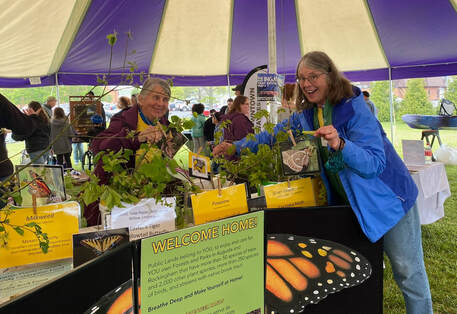 Virginia Master Naturalist volunteers in the Headwaters Chapter hosted a native plants and caterpillars display in Waynesboro. They also encouraged visitors to visit and care for the many public lands in their community. Photo by Janet James.
Virginia Master Naturalist volunteers in the Headwaters Chapter hosted a native plants and caterpillars display in Waynesboro. They also encouraged visitors to visit and care for the many public lands in their community. Photo by Janet James. Response
The Virginia Master Naturalist (VMN) program addresses these needs by supporting a statewide corps of volunteers providing education, outreach, and service dedicated to the beneficial management of natural resources and natural areas within their communities. With 30 chapters across Virginia, the program aims to extend the capacities of both state and local natural resource agencies and organizations to be able achieve their missions in new ways, engage new audiences, and work towards creating a citizenry more informed about and involved in natural resource conservation and management. The program, because of its chapter-based structure, also promotes learning about, exploring, and stewarding natural areas through social groups.
Every year, hundreds of Virginians become new VMN volunteers through training and service. The process for becoming a Certified VMN typically takes 6 to 12 months. One starts by completing a 40-hour basic training course offered by one the local chapters of the program. An additional 8 hours of continuing education and 40 hours of volunteer service are also required to become certified or recertified. Volunteer service hours are recorded in four primary areas: education, stewardship, citizen science, and chapter leadership. At the statewide level, the program is sponsored by seven state agencies, and on the local level, chapters partner with dozens of conservation and education organizations.
The Virginia Master Naturalist (VMN) program addresses these needs by supporting a statewide corps of volunteers providing education, outreach, and service dedicated to the beneficial management of natural resources and natural areas within their communities. With 30 chapters across Virginia, the program aims to extend the capacities of both state and local natural resource agencies and organizations to be able achieve their missions in new ways, engage new audiences, and work towards creating a citizenry more informed about and involved in natural resource conservation and management. The program, because of its chapter-based structure, also promotes learning about, exploring, and stewarding natural areas through social groups.
Every year, hundreds of Virginians become new VMN volunteers through training and service. The process for becoming a Certified VMN typically takes 6 to 12 months. One starts by completing a 40-hour basic training course offered by one the local chapters of the program. An additional 8 hours of continuing education and 40 hours of volunteer service are also required to become certified or recertified. Volunteer service hours are recorded in four primary areas: education, stewardship, citizen science, and chapter leadership. At the statewide level, the program is sponsored by seven state agencies, and on the local level, chapters partner with dozens of conservation and education organizations.
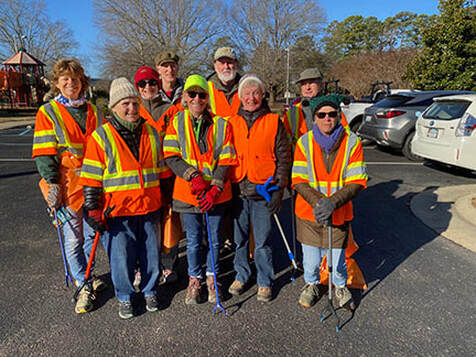 Virginia Master Naturalist volunteers in the Historic Rivers Chapter's litter team at Chickahominy Riverfront Park. Photo by Judy Jones.
Virginia Master Naturalist volunteers in the Historic Rivers Chapter's litter team at Chickahominy Riverfront Park. Photo by Judy Jones. Results
The VMN program currently has 2,400 volunteers who reported service in 2022. These volunteers completed more than 43,000 hours of basic training and continuing education in 2022. They also contributed significant volunteer time in the areas of education, citizen science, stewardship, and chapter administration, amounting to more than $6.5 million in contributions to natural resource conservation in Virginia (based on IndependentSector.org value of a volunteer hour.) Since the program’s inception in 2005, VMN volunteers have contributed more than 1.8 million hours of service with a value of $49 million to the Commonwealth of Virginia.
In 2022, VMN volunteers contributed more than 53,000 hours of stewardship, valued at $1.6 million, to improve local natural resource conditions on more than 500 sites through invasive plant management in parks, management of habitats for pollinators and other wildlife, maintenance of hundreds of miles of trails, and creation of more than 60 new habitat sites through planting and restoration projects. Volunteers also improved public lands through sustained efforts to clean up litter. For example, VMN volunteers in the Southern Piedmont Chapter organized regularly scheduled public events to pick up litter along area trails and waterways in Mecklenburg County. Along with removing several tons of litter, these events engaged other members of the community, and the VMN volunteers shared information about conservation and stewardship with attendees. The Historic Rivers Chapter conducted cleanups at more than 25 different parks, roads, trails, and shorelines in James City and York counties, and they were recognized for their work with the “Adopt A Trail Group of the Year” award from the Capital Trail Foundation. To increase the impacts of their work, the volunteers collected over 1,000 pounds of soft plastic and used it to earn durable plastic benches made by Trex, which the chapter has dedicated to the memory of three deceased volunteers. Their work has not only removed harmful plastics from the environment, but also honored beloved friends and provided more resting spots for people to enjoy local parks and trails.
The VMN program currently has 2,400 volunteers who reported service in 2022. These volunteers completed more than 43,000 hours of basic training and continuing education in 2022. They also contributed significant volunteer time in the areas of education, citizen science, stewardship, and chapter administration, amounting to more than $6.5 million in contributions to natural resource conservation in Virginia (based on IndependentSector.org value of a volunteer hour.) Since the program’s inception in 2005, VMN volunteers have contributed more than 1.8 million hours of service with a value of $49 million to the Commonwealth of Virginia.
In 2022, VMN volunteers contributed more than 53,000 hours of stewardship, valued at $1.6 million, to improve local natural resource conditions on more than 500 sites through invasive plant management in parks, management of habitats for pollinators and other wildlife, maintenance of hundreds of miles of trails, and creation of more than 60 new habitat sites through planting and restoration projects. Volunteers also improved public lands through sustained efforts to clean up litter. For example, VMN volunteers in the Southern Piedmont Chapter organized regularly scheduled public events to pick up litter along area trails and waterways in Mecklenburg County. Along with removing several tons of litter, these events engaged other members of the community, and the VMN volunteers shared information about conservation and stewardship with attendees. The Historic Rivers Chapter conducted cleanups at more than 25 different parks, roads, trails, and shorelines in James City and York counties, and they were recognized for their work with the “Adopt A Trail Group of the Year” award from the Capital Trail Foundation. To increase the impacts of their work, the volunteers collected over 1,000 pounds of soft plastic and used it to earn durable plastic benches made by Trex, which the chapter has dedicated to the memory of three deceased volunteers. Their work has not only removed harmful plastics from the environment, but also honored beloved friends and provided more resting spots for people to enjoy local parks and trails.
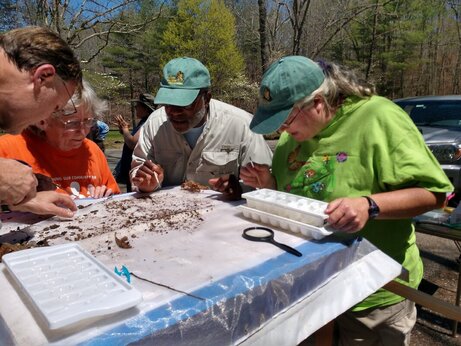 Virginia Master Naturalist volunteers in the Alleghany Highlands Chapter monitor the health of local streams to assist with assessing watershed health in the region and to contribute to databases used by the Virginia Department of Environmental Quality, the James River Association, and other partners. Photo by VMN-Alleghany Highlands Chapter.
Virginia Master Naturalist volunteers in the Alleghany Highlands Chapter monitor the health of local streams to assist with assessing watershed health in the region and to contribute to databases used by the Virginia Department of Environmental Quality, the James River Association, and other partners. Photo by VMN-Alleghany Highlands Chapter. Volunteers also contributed more than 75,000 hours of time, valued at $2.3 million, to more than 100 nature-based citizen science, community science, and crowdsourcing studies. For example, VMN volunteers in Arlington launched a local phenology project to monitor seasonal changes in native plants and investigate how habitat influences plant development. Their data also are part of a national database used to learn about climate change impacts. Volunteers in nearly every VMN chapter conducted biological and chemical monitoring of Virginia’s streams and rivers, resulting in data used by the Virginia Department of Environmental Quality and other partners to identify potential stream health issues and alert communities to health risks posed by bacterial contamination. VMN chapters also adopted 32 of 65 loops on the Virginia Bird and Wildlife Trail, conducting quarterly visits at hundreds of sites to report on site conditions and wildlife observations. Their data helped the Virginia Department of Wildlife Resources promote publicly-accessible places to watch wildlife in communities all over Virginia and to document species that visitors are likely to observe at those sites.
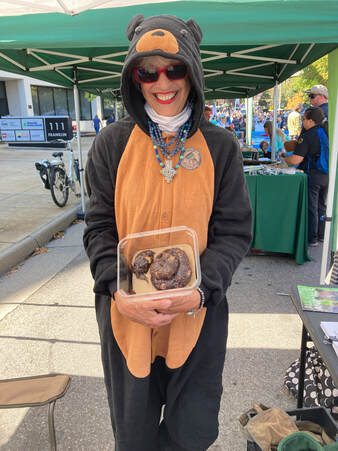 Sometimes a costume and some fake scat helps! Volunteers in the Roanoke Valley Chapter shared information at local festivals to help community members learn about bears and what we all can do to live in harmony with them. Photo by VMN-Roanoke Valley Chapter.
Sometimes a costume and some fake scat helps! Volunteers in the Roanoke Valley Chapter shared information at local festivals to help community members learn about bears and what we all can do to live in harmony with them. Photo by VMN-Roanoke Valley Chapter. In addition, volunteers made more than 288,473 direct contacts through educational programs in their communities that totaled 42,300 hours of service, valued at $1.3 million. In one new program launched in partnership with the Virginia Department of Wildlife Resources, VMN volunteers helped educate members of the public about changes they can make to reduce conflicts with black bears. They made more than 8,500 contacts with their “Living With Bears” booths at the Virginia State Fair, GoFest in Roanoke, and several local community events. Based on the questions and comments received, it was clear that their message was impactful. Volunteers also made specific efforts to connect with underrepresented audiences. For example, VMN volunteers in the Middle Peninsula Chapter partnered with local bird club and NAACP chapters to host a bird walk for Black Birders Week. Volunteers in the Rivanna Chapter collaborated with partners to train young people in one of Charlottesville’s most diverse urban neighborhoods to become Green Ambassadors, promoting tree plantings to reduce urban heat island effects. Fairfax Chapter volunteers reached out to Spanish-speaking audiences with information about stream health and other nature topics at events in predominantly Hispanic neighborhoods and during Latino Conservation Week.
 Interacting with wildlife face-to-face is often a highlight of Virginia Master Naturalist training in the Rivanna Chapter! Photo by Meg Clute.
Interacting with wildlife face-to-face is often a highlight of Virginia Master Naturalist training in the Rivanna Chapter! Photo by Meg Clute. On top of their contributions to these many conservation projects, VMN volunteers also contributed 40,000 hours of time, valued at $1.2 million, leading and managing our local chapters. The unique structure of the VMN program relies on volunteers to lead the day-to-day local operations of the program, including recruiting new volunteers, organizing training courses, developing local projects and partnerships, and tracking volunteer activities. Several hundred VMN volunteers provide this local leadership, without which the program would not exist. In 2022, these leaders organized 27 basic training courses, graduating more than 400 new VMN volunteers. They worked to re-organize those courses to be more engaging, accessible, and effective, which has resulted in more than 87% of 2022 basic training course graduates already contributing some volunteer service.


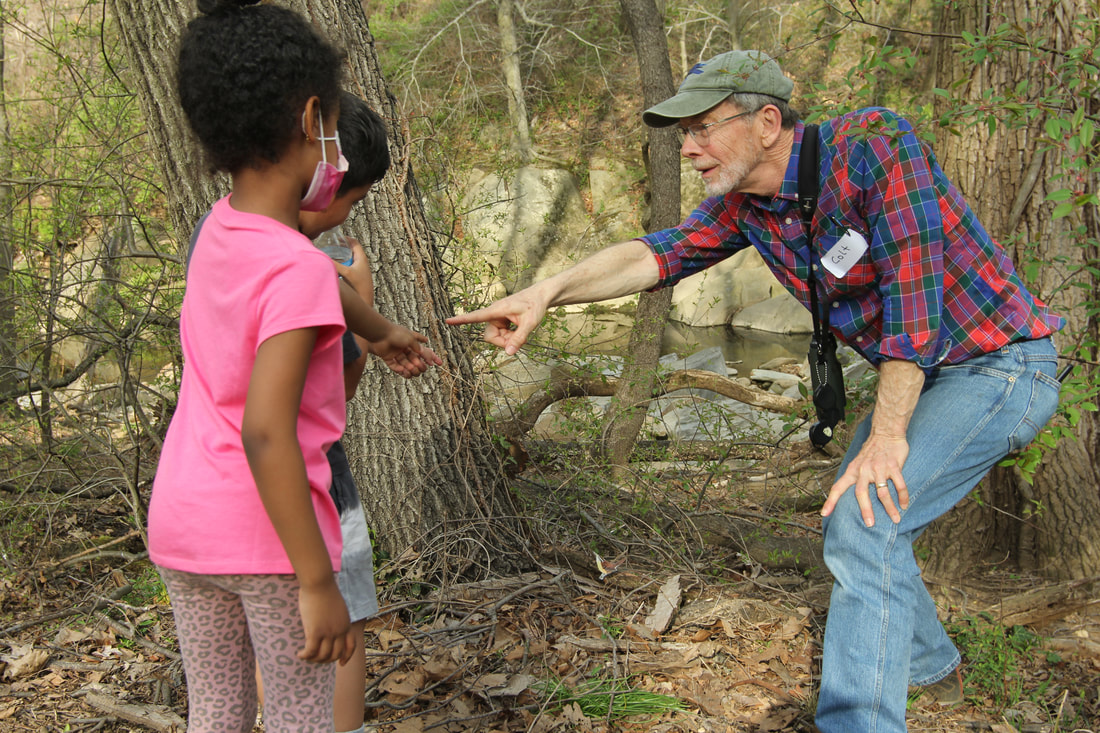
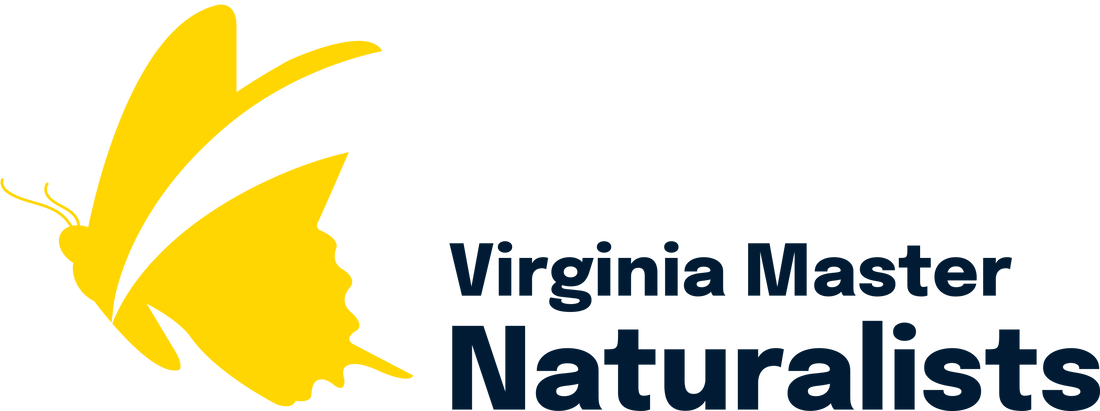
 RSS Feed
RSS Feed